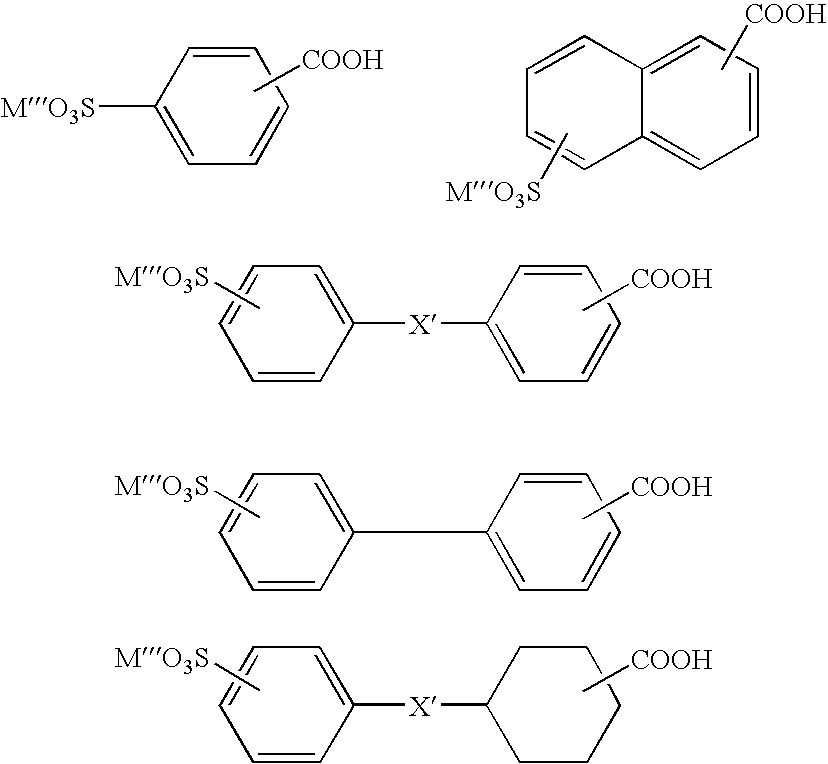Aldehyde removal
a technology of aldehyde and sulphur, which is applied in the direction of filtration separation, separation process, dispersed particle filtration, etc., can solve the problems of health problems, headache, nausea, and irritation of eyes, respiratory passages and skin, and the emission of formaldehyde gas
- Summary
- Abstract
- Description
- Claims
- Application Information
AI Technical Summary
Benefits of technology
Problems solved by technology
Method used
Image
Examples
example 1
Preparation of Acetoacetate-Functional Polyester
[0042]An adduct of neopentyl glycol and 5-sodiosulfoisophthalic acid was first prepared by reacting neopentyl glycol(NPG)(827 g, 7.95 mol), 5-sodiosulfoiso-phthalic acid (SIP)(536 g, 2.00 mol), water (91.9 g), and the acid catalyst FASCAT 4100 (1.10 g) in a three-neck, round-bottom flask equipped with a mechanical stirrer, a steam-jacketed partial condenser, a Dean-Stark trap, a nitrogen inlet, and a water condenser. The reaction temperature gradually was increased from 110 to 150° C. in a 45-minutr period, and the distillate collected in the Dean-Stark trap. The reaction was allowed to continue at 150 to 180° C. for 3 hours, and at 190° C. for 4 to 5 hours, until an acid number of 3.0 mg KOH / g was obtained. A portion of the resultant product was used in the following step.
[0043]A separate reactor equipped as described in the previous paragraph was charged with the NPG / SIP adduct (53.20 g) prepared as described in the preceding paragra...
example 2
Acetoacetate-Functional Polyester Containing Cu(II)
[0044]A portion (10 g) of the clear polyester dispersion of Example 1 was mixed with 5 g water and 1.8 g of a solution prepared by mixing 15 ml of solution A consisting of 7 g CuSO4 dissolved in 100 g water and 15 ml of solution B consisting of 35 g potassium sodium tartrate and 10 g NaOH dissolved in 100 g water to provide a composition containing about 1.7 % CuSO4. The composition thus obtained was coated onto polyester film as described above.
example 3
Preparation of Acetoacetate-Functional Latex
[0045]This example describes the procedure for making a latex having 20% AAEM residues and a Tg 20° C. DISPONIL FES 32 (sodium lauryl ether sulfate, available from Cognis Corp. Ambler, Pa.) was used as the surfactant for the reaction. To a 1-L, water-jacketed kettle equipped with a mechanical stirrer, a water condenser, a nitrogen inlet, and reactant feeding tubes were added water (119.50 g), DISPONIL FES 32 (3.11 g), and ammonium carbonate (0.41 g). The mixture then was gradually heated to 80° C. Separately, three solutions were prepared in the flasks: (1) an initiator solution of ammonium persulfate (APS, 0.55 g), ammonium carbonate (0.92 g), and water (25.00 g), (2) a kicker solution of ammonium persulfate (0.83 g) and water (12.53 g), and (3) a monomer pre-emulsion of methyl methacrylate (18.47 g), styrene (146.77 g), 2-ethylhexyl acrylate (122.97 g), methacrylic acid (7.39 g), 2-acetoacetoxyethyl methacrylate (AAEM, 73.90 g), FES 32 s...
PUM
| Property | Measurement | Unit |
|---|---|---|
| Temperature | aaaaa | aaaaa |
| Percent by mass | aaaaa | aaaaa |
| Percent by mass | aaaaa | aaaaa |
Abstract
Description
Claims
Application Information
 Login to View More
Login to View More - R&D
- Intellectual Property
- Life Sciences
- Materials
- Tech Scout
- Unparalleled Data Quality
- Higher Quality Content
- 60% Fewer Hallucinations
Browse by: Latest US Patents, China's latest patents, Technical Efficacy Thesaurus, Application Domain, Technology Topic, Popular Technical Reports.
© 2025 PatSnap. All rights reserved.Legal|Privacy policy|Modern Slavery Act Transparency Statement|Sitemap|About US| Contact US: help@patsnap.com



